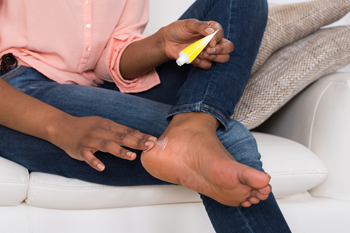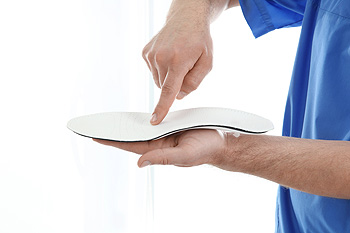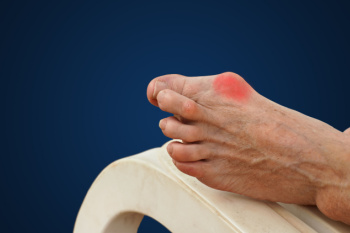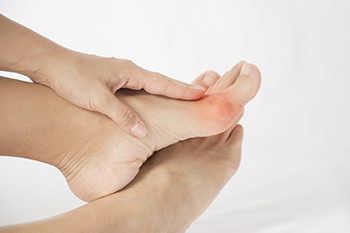Items filtered by date: April 2024
Causes of Cracked Heels
 Cracked and dry heels can be a bothersome and sometimes painful issue that many people face. There are several common causes behind this condition, including dry skin, lack of moisture, or standing for long periods. Wearing open-back shoes and specific medical conditions, such as diabetes or thyroid disease, can also contribute. People who have atopic dermatitis, psoriasis, and other skin issues may have a higher likelihood of developing cracked heels. When the skin on the heels becomes excessively dry, it loses its elasticity and may crack under pressure, leading to discomfort and potential complications if left untreated. Additionally, certain lifestyle factors, like inadequate hydration or poor foot care practices, can make the problem worse. Podiatrists, or foot doctors, can offer treatments, such as moisturizing creams, exfoliation, or custom orthotics, to provide relief and promote healing. If you are struggling with cracked or dry heels, it is suggested that you consult a podiatrist for help.
Cracked and dry heels can be a bothersome and sometimes painful issue that many people face. There are several common causes behind this condition, including dry skin, lack of moisture, or standing for long periods. Wearing open-back shoes and specific medical conditions, such as diabetes or thyroid disease, can also contribute. People who have atopic dermatitis, psoriasis, and other skin issues may have a higher likelihood of developing cracked heels. When the skin on the heels becomes excessively dry, it loses its elasticity and may crack under pressure, leading to discomfort and potential complications if left untreated. Additionally, certain lifestyle factors, like inadequate hydration or poor foot care practices, can make the problem worse. Podiatrists, or foot doctors, can offer treatments, such as moisturizing creams, exfoliation, or custom orthotics, to provide relief and promote healing. If you are struggling with cracked or dry heels, it is suggested that you consult a podiatrist for help.
If the skin on your feet starts to crack, you may want to see a podiatrist to find treatment. If you have any concerns, contact one of our podiatrists from Ankle & Foot of Edmonds. Our doctors can provide the care you need to keep you pain-free and on your feet.
Cracked Heels
It is important to moisturize your cracked heels in order to prevent pain, bleeding, and infection. The reason cracked heels form is because the skin on the foot is too dry to support the immense pressure placed on them. When the foot expands, the dry skin on the foot begins to split.
Ways to Help Heal Them
- Invest in a good foot cream
- Try Using Petroleum Jelly
- Ease up on Soaps
- Drink Plenty of Water
Ways to Prevent Cracked Heels
- Moisturize After Showering
- Skip a Shower
- Keep Shower Water Lukewarm
- Don’t Scrub Your Feet
If you are unsure how to proceed in treating cracked heels, seek guidance from a podiatrist. Your doctor will help you with any questions or information you may need.
If you have any questions, please feel free to contact our office located in Edmonds, WA . We offer the newest diagnostic and treatment technologies for all your foot care needs.
Custom Orthotics For Foot and Heel Pain

Step into relief and reclaim your mobility! Foot and heel pain can be a thing of the past with the right Custom Orthotics. Customized to your unique foot structure, they provide the support and alignment needed to alleviate discomfort. Whether you're walking, running, or simply standing, Custom Orthotics ensure every step is cushioned and pain-free. Don't let foot ailments dictate your day. With Custom Orthotics, embrace a world of comfort and freedom. Call today to schedule an appointment.
Foot Injuries From Rock Climbing

Rock climbing, an exhilarating sport enjoyed by many, can also pose risks of foot injuries, both acute and chronic. Acute injuries often occur due to sudden trauma or overuse during climbs. Common acute foot injuries include sprains, strains, fractures, and abrasions, often resulting from slips, falls, or improper foot placements. Climbing shoes, designed for precision and grip, can exacerbate foot issues if they fit too tightly or lack proper support. Wearing ill-fitting shoes may lead to blisters, corns, or ingrown toenails, while prolonged use can contribute to conditions like plantar fasciitis or tendonitis. If you participate in rock climbing and have sustained a foot injury, it is suggested that you schedule an appointment with a podiatrist for diagnosis and treatment. These healthcare professionals can also provide guidance on proper shoe fit, and recommend supportive inserts, and custom-made orthotics.
Ankle and foot injuries are common among athletes and in many sports. They can be caused by several problems and may be potentially serious. If you are feeling pain or think you were injured in a sporting event or when exercising, consult with one of our podiatrists from Ankle & Foot of Edmonds. Our doctors will assess your condition and provide you with quality foot and ankle treatment.
Common Injuries
The most common injuries that occur in sporting activities include:
- Achilles Tendonitis
- Achilles Tendon Rupture
- Ankle Sprains
- Broken Foot
- Plantar Fasciitis
- Stress Fractures
- Turf Toe
Symptoms
Symptoms vary depending upon the injury and in some cases, there may be no symptoms at all. However, in most cases, some form of symptom is experienced. Pain, aching, burning, bruising, tenderness, tightness or stiffness, sensation loss, difficulty moving, and swelling are the most common symptoms.
Treatment
Just as symptoms vary depending upon the injury, so do treatment options. A common treatment method is known as the RICE method. This method involves rest, applying ice, compression and elevating the afflicted foot or ankle. If the injury appears to be more serious, surgery might be required, such as arthroscopic or reconstructive surgery. Lastly, rehabilitation or therapy might be needed to gain full functionality in the afflicted area. Any discomfort experienced by an athlete must be evaluated by a licensed, reputable medical professional.
If you have any questions, please feel free to contact our office located in Edmonds, WA . We offer the newest diagnostic and treatment technologies for all your foot care needs.
The Role of Orthotics in Managing Diabetic Foot Problems

Orthotics can play an important role in managing foot problems associated with diabetes, which can include neuropathy, poor circulation, and foot deformities. Custom orthotics provide essential support and cushioning, reducing pressure on sensitive areas of the foot and preventing the formation of ulcers. They help distribute weight evenly, alleviating hotspots that can lead to skin breakdown and infection. Additionally, orthotics can correct biomechanical abnormalities and promote proper foot alignment, reducing the risk of foot deformities and improving overall stability. For diabetic individuals, orthotics are often designed with materials that offer extra padding and shock absorption to minimize friction and protect vulnerable areas. If you are a diabetic and experiencing foot problems, it is strongly suggested that you make an appointment with a podiatrist for an evaluation and a discussion of custom-made foot orthotics as part of your treatment. Regular monitoring and adjustments by a podiatrist are needed so that orthotics remain effective and accommodate any changes in foot structure or condition.
Custom orthotics and shoe inserts are not just for cushioning the soles; they are about supporting the foundation of our body - our feet. The advantages extend far beyond immediate relief from discomfort. These personalized solutions, that Our doctors can prescribe, can significantly impact a person’s posture, alleviate pain in various parts of the body, and even enhance athletic performance.
As we lace up our shoes each day, having the right support can make a world of difference. Custom orthotics are like tailored suites for our feet, offering a bespoke solution to address our unique biomechanical needs. They provide stability where it is lacking, correct imbalances, and ensure that every step is a confident and pain-free one.
Custom orthotics and shoe inserts offer long-term health benefits. By addressing issues such as overpronation or underpronation, heel pain, plantar fasciitis, etc. orthotics can help prevent injuries and mitigate the progression of existing conditions. It’s an investment not just in the present, but in the future health of your feet and consequently, your overall well-being.
If you have any questions please contact our office located in Edmonds, WA . We offer the newest diagnostic and treatment technologies for all your foot and ankle needs.
Are You Suffering From Ingrown Toenails?
What Happens During Bunion Surgery
 The goal of bunion surgery is to correct the deformity of the big toe that causes pain and discomfort. The procedure generally involves an incision in the foot near the big toe to access the bunion. The bones, ligaments, tendons, and nerves are then realigned to correct the deformity. In some cases, small pieces of bone might be removed, or the bones may be cut and realigned with pins or plates to maintain the correct position. The specific technique used depends on the severity of the bunion and the patient's foot structure. After surgery, the foot is typically bandaged. Patients may need to wear a special boot or shoe to protect the foot and keep it in the correct position during the healing process. Recovery time varies, but it generally involves several weeks of limited movement to allow the foot to heal properly. Follow-up visits with the podiatrist are important to monitor the healing process and begin rehabilitation exercises to restore strength and mobility to the foot. If you have a bunion, it is suggested that you schedule an appointment with a podiatrist to discuss whether bunion surgery is right for you.
The goal of bunion surgery is to correct the deformity of the big toe that causes pain and discomfort. The procedure generally involves an incision in the foot near the big toe to access the bunion. The bones, ligaments, tendons, and nerves are then realigned to correct the deformity. In some cases, small pieces of bone might be removed, or the bones may be cut and realigned with pins or plates to maintain the correct position. The specific technique used depends on the severity of the bunion and the patient's foot structure. After surgery, the foot is typically bandaged. Patients may need to wear a special boot or shoe to protect the foot and keep it in the correct position during the healing process. Recovery time varies, but it generally involves several weeks of limited movement to allow the foot to heal properly. Follow-up visits with the podiatrist are important to monitor the healing process and begin rehabilitation exercises to restore strength and mobility to the foot. If you have a bunion, it is suggested that you schedule an appointment with a podiatrist to discuss whether bunion surgery is right for you.
Foot surgery is sometimes necessary to treat a foot ailment. To learn more, contact one of our podiatrists of Ankle & Foot of Edmonds. Our doctors will assist you with all of your foot and ankle needs.
When Is Surgery Necessary?
Foot and ankle surgery is generally reserved for cases in which less invasive, conservative procedures have failed to alleviate the problem. Some of the cases in which surgery may be necessary include:
- Removing foot deformities like bunions and bone spurs
- Severe arthritis that has caused bone issues
- Cosmetic reconstruction
What Types of Surgery Are There?
The type of surgery you receive will depend on the nature of the problem you have. Some of the possible surgeries include:
- Bunionectomy for painful bunions
- Surgical fusion for realignment of bones
- Neuropathy decompression surgery to treat nerve damage
Benefits of Surgery
Although surgery is usually a last resort, it can provide more complete pain relief compared to non-surgical methods and may allow you to finally resume full activity.
Surgical techniques have also become increasingly sophisticated. Techniques like endoscopic surgery allow for smaller incisions and faster recovery times.
If you have any questions please feel free to contact our office located in Edmonds, WA . We offer the newest diagnostic and treatment technologies for all your foot and ankle needs.
Symptoms and Management of Bunions

Bunions, a common foot condition, present noticeable symptoms that can affect daily life. One prominent indication is a bony bump that forms at the base of the big toe, causing it to lean inward toward the other toes. This misalignment often leads to pain, swelling, redness, and restricted movement in the affected area. As bunions progress, they can cause discomfort, making it challenging to find comfortable footwear and engage in regular activities. However, several strategies can help manage bunions and alleviate symptoms. Wearing shoes with a wide toe box can reduce pressure on the bunion and provide ample space for the toes. Engaging in gentle stretching exercises can help to relieve pain and inflammation. In severe cases, where conservative measures fail to provide relief, surgical intervention may be considered to correct the underlying structural deformity. If you have a bunion, it is suggested that you are under the care of a podiatrist who can monitor its progression, and offer effective management techniques.
If you are suffering from bunion pain, contact one of our podiatrists of Ankle & Foot of Edmonds. Our doctors can provide the care you need to keep you pain-free and on your feet.
What Is a Bunion?
Bunions are painful bony bumps that usually develop on the inside of the foot at the joint of the big toe. As the deformity increases over time, it may become painful to walk and wear shoes. Women are more likely to exacerbate existing bunions since they often wear tight, narrow shoes that shift their toes together. Bunion pain can be relieved by wearing wider shoes with enough room for the toes.
Causes
- Genetics – some people inherit feet that are more prone to bunion development
- Inflammatory Conditions - rheumatoid arthritis and polio may cause bunion development
Symptoms
- Redness and inflammation
- Pain and tenderness
- Callus or corns on the bump
- Restricted motion in the big toe
In order to diagnose your bunion, your podiatrist may ask about your medical history, symptoms, and general health. Your doctor might also order an x-ray to take a closer look at your feet. Nonsurgical treatment options include orthotics, padding, icing, changes in footwear, and medication. If nonsurgical treatments don’t alleviate your bunion pain, surgery may be necessary.
If you have any questions, please feel free to contact our office located in Edmonds, WA . We offer the newest diagnostic and treatment technologies for all your foot care needs.

